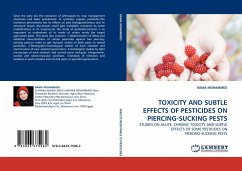
Use safe alternatives to pesticides for control some agricultural pests
Versandkostenfrei!
Versandfertig in 1-2 Wochen
26,99 €
inkl. MwSt.

PAYBACK Punkte
13 °P sammeln!
Biological, food consumption and control studies were investigated against the gray garden slug, Deroceras reticulatum (Müller) under laboratory conditions. Results show that slugs began egg - laying in early January, and deposited clusters each containing from 21 to 43 oval eggs in or a top the soil. Eggs measured about 2 mm in length and 3 mm in width. The transformation being seen through a change of eggs color, from a white color into a pale buff after a week of egg laying. Eggs take from 23 to 27 days to hatch and the hatching period ranged between 6 to 11 days. Hatchability varied betwe...
Biological, food consumption and control studies were investigated against the gray garden slug, Deroceras reticulatum (Müller) under laboratory conditions. Results show that slugs began egg - laying in early January, and deposited clusters each containing from 21 to 43 oval eggs in or a top the soil. Eggs measured about 2 mm in length and 3 mm in width. The transformation being seen through a change of eggs color, from a white color into a pale buff after a week of egg laying. Eggs take from 23 to 27 days to hatch and the hatching period ranged between 6 to 11 days. Hatchability varied between 79% and 97.3%. Average life span was 55.3 weeks and the post oviposition period recorded about 69.6 days. The mean generation time varied between 50 and 52 weeks. These results indicate that D. reticulatum has one generation per year. The amount of leaf tissue consumed per day by adult slugs was more than the other which consumed by juveniles. 0.45, 0.28, 0.18 and 0.16 mg were the means offood consumed by juveniles for potato, cabbage, carrots and lettuce, respectively.












